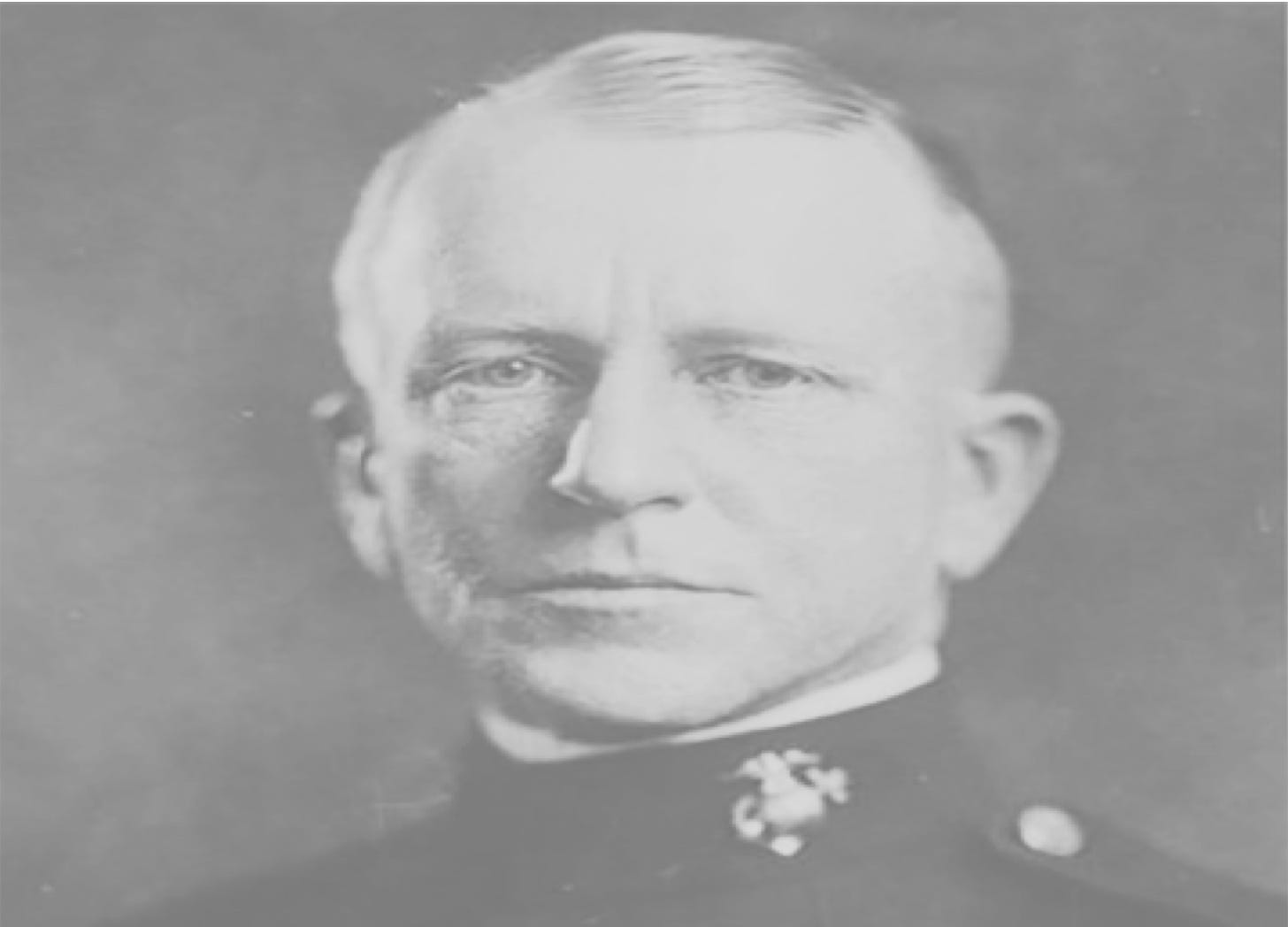Tactical Problems
James Carson Breckinridge, USMC
Commissioned in 1899, James Carson Breckinridge (1877-1942) served on active duty in the United States Marine Corps for close 42 years. A serious student of military history, tactics, and the art of teaching, he commanded the Marine Corps Schools in Quantico on two separate occasions, the first time (in 1928 and 1929) for 18 months and second time (between 1931 and 1934) for 36 months.
Several years ago, I found two copies of following essay in the archives of the Marine Corps University, one in the Historical Amphibious File (Folder 631) and one in the papers of Lieutenant General Breckinridge (Box 119, Folder 4). One of these two typescripts, dated 8 December 1934, bears hand-written references to a pair of slides. This suggests, at least to me, that the essay may have been delivered as a lecture.
The art of framing orders, pursuant to which there will be tactical movement of material and personnel, is not a natural gift. Although it may be readily developed in a terse and logical mind, it cannot be developed by mere study of text books. It involves the actual and personal solving of tactical problems which, in order to envisage the raison d'être, must be followed by physical demonstration. Beginning with simple problems of maneuvers which can be carried in the head and wholly grasped, the student of tactics should be gradually led into more and more intricate situations and solutions, until in the end, he commits his mind automatically to chart and map, disposing of forces too vast and too complicated for any person to conduct in mental continuity.
Hand in glove, coincidently, with the framing of orders must be the demonstration of the physical consequences resulting therefrom, and it is indeed difficult to realize what direction these actions will assume when transposed from the paper upon which they are written into physical movement upon the earth's surface. The person framing orders has in his mind a thought-out plan of action which has been built up through a mental analysis of the situation. Following this he desires to transfer from his mind to a written paper such combinations of words as will convey his thoughts (in orders) to others; the purpose is that others shall receive through the written page the mental impression as it existed in the mind of the writer.
To effect this is an art. Only through infinite practice in order writing, and followed by the physical execution of that which has been written, can one become even remotely accurate in transferring his wishes from his mind to that of another. Upon witnessing the execution of his written order the embryo tactician may well exclaim: ‘But that is not at all what I wanted!’ and probably it is not; but it is what he ordered just the same. In no other effort does the old saying apply more appropriately, that ‘brevity is the soul of wit’.
Physical demonstration being, for purposes of minor education, too vast and too costly if pursued on a scale of one hundred, must be reduced to dimensions suitable for maps, charts, and game boards, where, in connection with imaginary military problems, the tactical maneuvers resulting from problem solutions and the accompanying order writing, may be affected upon a reduced scale, but nevertheless graphically demonstrated before the eyes of the tactical student. Beginning with tactical problems of the simplest nature, working these out in minutest detail, and thus advancing step by progressive step until ultimately a point is reached where tactics imperceptibly merges itself into the realm of strategy, the student of military subjects will advance to the point where he cannot only accurately convey his wishes to others but can envisage the results of these wishes long before they are actually maneuvered.
War games simulate phases of war upon reduced scale, and as there are no cast rules for war there is immediate difficulty in framing arbitrary rules for games. Some of the greatest military achievements of history have been in violation of most accepted standards, and the only way a battle can be ‘proved’ is by the result, when of course it is too late to change the preparatory plans. Study of history and the lives, but more particularly the thoughts and actions, of the ‘Great Captains’, is the one sure guide in military craft.
There is no ‘right’ and no ‘wrong’ solution to any military problem as in mathematics. Whether a solution is right or wrong depends upon the result of physical encounter. Circumstances alter cases, but there are nevertheless accepted theories to depart from which is in most instances dangerous. Military problems are founded upon accepted theories, and governed by rules which comply with the laws of averages and probabilities. Beyond a doubt they educate and advance the majority of officers; and compliance with arbitrary rules in order to acquire the techniques which is necessary for average officers cannot in the long run hamper the originality of a genius, or an officer far above the average.
One of the standard requisites for land battle is an open way for retreat or withdrawal; this is a tactical necessity never overlooked by soldiers, and emphasized by Napoleon. In the sense that an open way for withdrawal means also a rear safe for supply – it is equally pondered and provided by naval commanders. Yet this apparently elemental and vital requirement has been so often evaded as to give rise to interesting tactical paradoxes. For example, William the Conqueror invading England in 1066 ordered his ships ‘to be beached and dismasted, so that all idea of retreat might be prevented’. After thus rendering withdrawal an impossibility he marched forward to Hastings.1
Burning ships to prevent retreat was once so frequently done as to appear almost orthodox. Thus Agathocles of Syracuse (310-307 B.C.) on an expedition against Carthage burned his ships when he landed.2 So did Julian the Apostate in his expedition against King Sapor of Persia (A.D. 363), and Guiscard in his expedition against the Greek Emperor Alexius in 1084, and Cortez when he landed upon the coast of Mexico in 1519.3
The exploits of Nelson at the Nile, Copenhagen, and Trafalgar have already been cited in connection with violation of accepted methods of warfare, and now to bring the discussion up to date, Marshall Foch, during the battle of the Marne, reported to his Commander in Chief: ‘My left has been forced back, my right is routed; I shall attack with my center.’ Having a line of battle utterly unfit for anything but reorganization, being faced with a tactically untenable situation, he proceeded to turn what appeared to be a disastrous liability into an immediate asset.4
Incidents such as these cannot be taught by any amount of problem analysis; they are beyond the range of stereo-typed technique. To apply to them any rule whatever would be dangerous in the extreme. So far as history shows Marshall Foch was the only one of the personages above named who lived during the era of the tactical problem, and no such problem ever taught him to attack with a line one flank of which had been ‘forced back’ and the other ‘routed’.
Familiarity with the intricate but somewhat narrow technique of the tactical problem would, of itself, not be an unmixed benefit; it needs supplementing by study of historical precedent and much broad reading. Although conditions are made dimensionally realistic, all arms and other factors being assigned relative values, and justly arbitrary results follow standardized acts, the problem can never be more than artificial and mechanical.
The powerful elements of human nature cannot be assigned a weight; these were the elements upon which Nelson depended when he deliberately violated all rules of warfare, and which responded to Marshall Foch's order when he attacked with an army that would have been ruled off any game board. Those personnel characteristics that are inherent in isolated cases, that are in truth flashes of genius, should be studied and admired, but not copied in order to emulate the eccentricity of genius!
No man can acquire genius, and when it is inherent in a man he does not know it. For the average officer the tactical problem develops system, method, concentrated continuity of thought, and the consideration of all effort in connection with the probable result. It will raise the standard of the average, but it will never produce genius.
For Further Reading:
To Share, Support, or Subscribe:
Duke William of Normandy (‘William the Bastard’”) defeated King Harold Godwinson at the Battle of Hastings (14 October 1066), thereby establishing Norman rule in England.
Agathocles (361 BC to 289 BC) was a man of humble origins who became dictator of the Greek city of Syracuse.
Julian the Apostate was a Roman emperor who, because of poor planning in the realm of logistics, proved unable to exploit his victory over the Persian king Sapor II (also known as Shapur II) at the battle of Ctesiphon, on 29 May 363 AD. Robert Guiscard (‘Robert the Resourceful’) was a Norman adventurer who inflicted many defeats on the forces of Alexius I, emperor of Byzantium, between 1081 AD and 1085 AD. Hernán Cortés was a Spanish soldier who, between 1519 AD and 1521 AD, destroyed the Aztec Empire.
Horatio Nelson (1751-1895) was a British naval officer who won many victories during the Napoleonic Wars. He was famous for his use of an approach to command based upon commander’s intent, a high degree of trust, and implicit communication. Ferdinand Foch (1851-1929) was a French soldier who commanded the Ninth Army at the First Battle of the Marne (6-12 September 1914.) A passionate advocate of the use of decision games in military training, he is famous for the question he frequently posed participants in such exercises. ‘What’, he would ask, ‘is really going on here?’ (‘De quoi s’agit-il?’)








